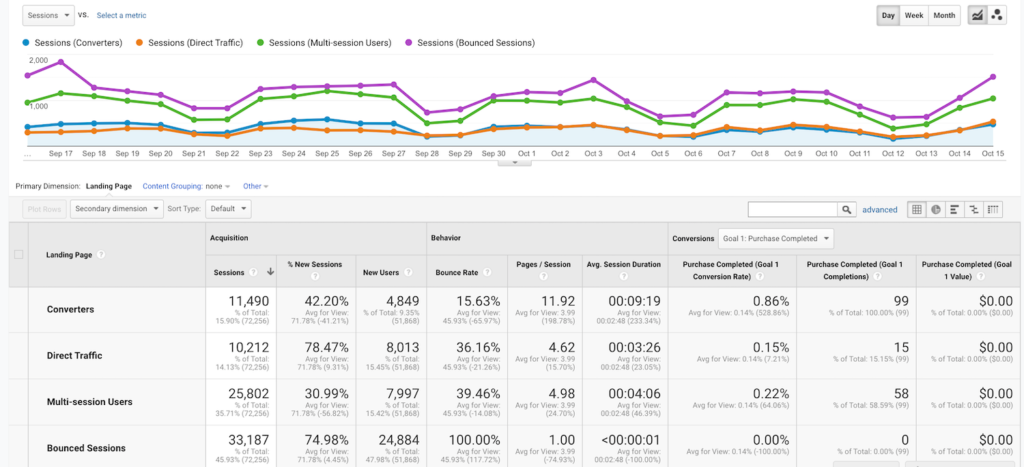What Data Is Google Analytics Goals Unable to Track: Learn the Limitations
What Data Is Google Analytics Goals Unable to Track: Learn the Limitations
Blog Article
Unveiling the Blind Destinations: Comprehending What Google Analytics Goals Can not Determine
In the realm of digital analytics, Google Analytics stands as an effective tool for tracking and assessing on-line individual interactions. Comprehending what Google Analytics goals can not determine is essential for acquiring a thorough sight of individual behavior and involvement.
Individual Behavior on External Operatings Systems
Understanding just how users connect on outside systems is vital for optimizing on-line strategies. Exterior platforms, such as social media sites networks, recommendation internet sites, and on the internet discussion forums, play a considerable duty in driving traffic to a business's website. By examining user habits on these systems, companies can get important understandings right into the effectiveness of their advertising and marketing efforts and the preferences of their target market.
One trick aspect of individual actions on outside systems is the referral source. By tracking where the customers are originating from, organizations can identify which platforms are driving one of the most traffic to their internet site. This information can help business allot their resources much more successfully, concentrating on the platforms that yield the very best outcomes.

Offline Communications and conversions
Assessing customer habits on outside platforms supplies important insights into on the internet methods; nonetheless, thinking about offline conversions and communications is similarly crucial for an extensive understanding of a firm's general performance. Offline conversions, such as in-store acquisitions or phone inquiries, play a substantial function in several services' success.

Attribution Beyond Last Click
When delving right into the world of digital marketing analytics, it becomes important to look beyond the single touchpoint of the last click for a much more comprehensive understanding of acknowledgment. While Google Analytics gives useful understandings into individual actions, counting solely on last-click attribution can be limiting - what data is google analytics goals unable to track. Attribution designs that exceed the last click supply a more nuanced view of the customer journey, taking into consideration all the touchpoints that result in a conversion
Acknowledgment past the last click enables marketers to assign credit score to numerous communications along the conversion course, providing a clearer picture of the performance of various advertising and marketing networks. By exploring multi-touch attribution versions such as straight, time decay, or position-based attribution, businesses can much better designate their advertising budgets and maximize their approaches for maximum impact.
Recognizing the impact of each touchpoint in the conversion process is essential for making educated choices and optimizing ROI. that site By welcoming attribution beyond the last click, services can acquire much deeper understandings into consumer behavior and customize their advertising efforts more successfully.
Cross-Device and Cross-Browser Tracking

Similarly, cross-browser tracking matches cross-device monitoring by recording user behavior as they change in between various Visit Your URL internet internet browsers. Understanding how individuals connect with internet sites on various browsers can help marketing experts maximize their online experiences to ensure consistency and functionality across different platforms.
Qualitative Data and Individual Intent
Comprehending individual intent with qualitative data analysis is crucial for developing targeted electronic marketing strategies that reverberate with the needs and preferences of the target audience. Qualitative data provides insights right into the 'why' behind customer activities, losing light on inspirations, feelings, and choices that measurable information alone can not catch. By examining individual responses, remarks, and interactions, online marketers can uncover valuable details concerning individual intent, enabling them to tailor their messaging, web content, and offerings to much better line up with what their audience is looking for.
Qualitative information also aids in recognizing the context in which individuals engage with a website or application. This contextual understanding allows online marketers to develop even more pertinent and individualized experiences, ultimately driving greater interaction and conversion rates. By diving into user intent via qualitative data evaluation, services can gain a much deeper understanding of their target audience, bring about a lot more effective advertising strategies that fulfill users' demands and expectations.
Conclusion
Finally, Google Analytics goals have constraints in measuring customer behavior on exterior platforms, offline conversions, acknowledgment beyond last click, cross-device and cross-browser monitoring, and qualitative data connected to user intent. what data is google analytics goals unable to track. It is very important for companies to be aware of these unseen areas in order to supplement their data evaluation with other devices and methods to obtain a much more thorough understanding of their audience and enhance their total digital advertising and marketing strategies
By examining customer behavior on these platforms, organizations can gain important understandings right into the effectiveness of their marketing efforts and the choices of their target audience.
Assessing user behavior on outside platforms supplies beneficial insights into on the internet approaches; nonetheless, thinking about offline conversions and communications is just as vital for a thorough understanding of a firm's overall performance.In digital advertising analytics, moving beyond last-click acknowledgment to discover cross-device and cross-browser monitoring is essential for acquiring an alternative understanding of individual communications throughout different platforms and gadgets. By evaluating individual comments, comments, and browse around this web-site interactions, marketers can reveal beneficial details concerning customer intent, allowing them to tailor their messaging, content, and offerings to better straighten with what their audience is looking for.
By diving into user intent via qualitative information evaluation, services can acquire a deeper understanding of their target audience, leading to more reliable advertising and marketing methods that satisfy users' needs and assumptions.
Report this page